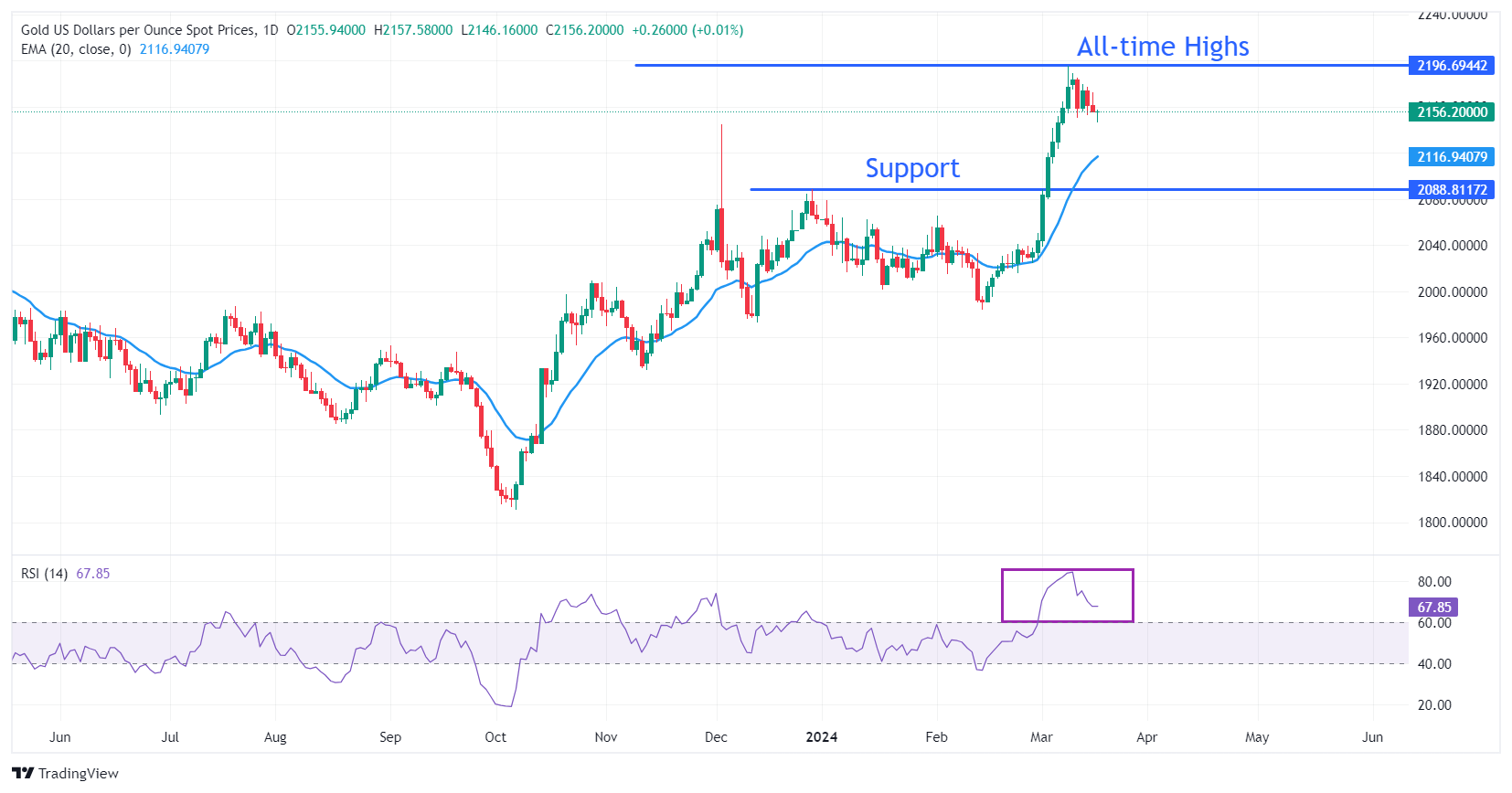Gold price faces pressure as key central bank meetings loom large
- Gold price falls slightly as US yields remain firm due to diminished Fed rate cut expectations for June.
- The US Dollar remains subdued as upbeat China data improves risk appetite.
- This week, the Fed’s decision and guidance on interest rates will be keenly watched.
Gold price (XAU/USD) exhibits a subdued performance in Monday’s European session. Fading expectations for the Federal Reserve (Fed) reducing interest rates in the June policy meeting have strengthened yields on interest-bearing assets. 10-year US Treasury yields have extended their upside to 4.31%, up by 0.16%. Higher US bond yields have increased the opportunity cost of holding an investment in non-yielding assets such as Gold weighing on its price.
The US Dollar Index (DXY) trades slightly lower at 103.40 due to improved risk appetite. The appeal for safe-haven assets has dampened due to the strong recovery in Chinese Retail Sales and Industrial Production data for February, which signals an improvement in domestic demand. This weaken appeal for safe havens has also built downside pressure on the Gold price.
This week, the Gold price will be guided by the Fed’s interest rate decision, which will be announced on Wednesday. The Fed is widely anticipated to keep interest rates unchanged in the range of 5.25%-5.50%. Therefore, the major focus will be on the interest rate guidance, which will be provided through the release of the so-called dot plot, a chart updated quarterly that shows interest rate projections from Fed officials for various timeframes.
Daily digest market movers: Gold price falls slightly amid caution ahead of Fed meeting
- Gold price turns subdued near $2,150 as investors await key interest rate meetings by various central banks this week. The near-term for the Gold price will be guided by the Federal Reserve’s monetary policy decision.
- The CME FedWatch tool shows that a steady decision for the March meeting is certain. Market participants will keenly focus on the dot plot, which indicates all policymakers' expectations for interest rates over time and the latest economic projections. Investors will look for cues about when the Fed could start cutting interest rates.
- December’s dot plot showed policymakers don’t see the need to increase interest rates further and see three rate cuts this year. The Consumer Price Index (CPI) and associated inflation indicators for the first two months of 2024 have not been supportive of three rate cuts, as Fed policymakers want price pressures to decline for months to become confident that inflation will return to the 2% target. This could result in fewer rate-cut projections from Fed policymakers.
- Meanwhile, market expectations lean towards the June policy meeting when the Fed will start reducing key borrowing rates. However, the chances for the rate cut in June have come down significantly, as the consumer and producer price indices were surprisingly stubborn in February. The CME FedWatch tool shows that the chance for a rate cut stands at 57%, down from the 72% recorded before the release of the inflation data.
- Later this week, investors will focus on the preliminary S&P Global Manufacturing PMI for March. The Manufacturing PMI is anticipated to fall to 51.7 from 52.2 in February.
Technical Analysis: Gold price remains below $2,160
Gold's price has hit a fresh weekly low at around $2,145. As the divergence between the two is waning, the precious metal may continue its downside towards the 20-day Exponential Moving Average (EMA) at $2,097. After a wide divergence, the asset tends to face a mean-reversion move, which results in a price or a time correction.
On the downside, December 4 high near $2,145 and December 28 high at $2,088 will act as major support levels.
The 14-Relative Strength Index (RSI) retraces from its peak near 84.50, although the upside momentum is still active.
Gold FAQs
Gold has played a key role in human’s history as it has been widely used as a store of value and medium of exchange. Currently, apart from its shine and usage for jewelry, the precious metal is widely seen as a safe-haven asset, meaning that it is considered a good investment during turbulent times. Gold is also widely seen as a hedge against inflation and against depreciating currencies as it doesn’t rely on any specific issuer or government.
Central banks are the biggest Gold holders. In their aim to support their currencies in turbulent times, central banks tend to diversify their reserves and buy Gold to improve the perceived strength of the economy and the currency. High Gold reserves can be a source of trust for a country’s solvency. Central banks added 1,136 tonnes of Gold worth around $70 billion to their reserves in 2022, according to data from the World Gold Council. This is the highest yearly purchase since records began. Central banks from emerging economies such as China, India and Turkey are quickly increasing their Gold reserves.
Gold has an inverse correlation with the US Dollar and US Treasuries, which are both major reserve and safe-haven assets. When the Dollar depreciates, Gold tends to rise, enabling investors and central banks to diversify their assets in turbulent times. Gold is also inversely correlated with risk assets. A rally in the stock market tends to weaken Gold price, while sell-offs in riskier markets tend to favor the precious metal.
The price can move due to a wide range of factors. Geopolitical instability or fears of a deep recession can quickly make Gold price escalate due to its safe-haven status. As a yield-less asset, Gold tends to rise with lower interest rates, while higher cost of money usually weighs down on the yellow metal. Still, most moves depend on how the US Dollar (USD) behaves as the asset is priced in dollars (XAU/USD). A strong Dollar tends to keep the price of Gold controlled, whereas a weaker Dollar is likely to push Gold prices up.







